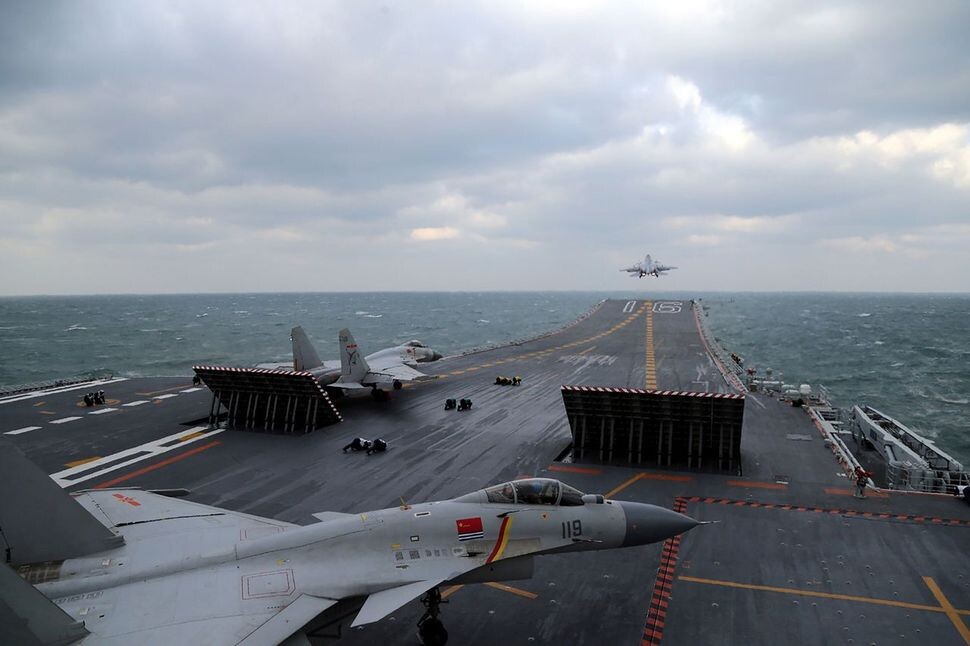hankyoreh
Links to other country sites 다른 나라 사이트 링크
Chinese newspaper says Korean peninsula most likely location of armed clash in 2017

Major Chinese news outlets named the Korean Peninsula on Jan. 3 as the most likely region for an armed clash to occur in 2017.
In an editorial titled “Will The World Be More Chaotic in 2017?” the Global Times wrote, “From the perspective of war or new military clashes, the West Pacific is the most dangerous zone.”
“The Korean Peninsula is the primary target,” it continued, adding that the possibility of US President-elect Donald Trump taking an extreme hard line on Pyongyang could not be ruled out.
The editorial went on to say that while the US and China’s broad and complicated relationship has been bound by policy in the past, a more chaotic situation where anything could happen in the West Pacific region if Trump chooses to ignore those restraints.
The editorial named the Taiwan Straits as the next most likely setting for a clash, predicting the region could be become more dangerous if current Taiwanese President Tsai Ing-wen becomes more overt about her pro-independence leanings. In contrast, it limited the likelihood of clashes in the South China Sea - where Beijing is currently enjoying a “honeymoon” with the administration of Philippines President Rodrigo Duterte - to situations involving the US.
“The South China Sea seems to remain moderate, and the only cause of a military confrontation in the waters would be China-US rivalry,” the piece said.
At the same time, it also hinted that the South China Sea issue could flare up into an all-out clash between the US and China.
“Once [a confrontation] occurs, it will have an overall impact,” the piece said, noting the potential for such a situation to become a far-reaching shock.
While the editorial saw little potential for a confrontation in the East China Sea - where China has been in conflict with Japan over the Senkaku (Diaoyudao) Islands - it added that the possibility could not be ruled out.
The Chinese Navy appears poised to continue with exercises by its Liaoning aircraft carrier in the Bohai Sea, West (Yellow) Sea, East China Sea, West Pacific, and South China Sea, which have been taking place since Trump’s statements about Taiwan and the South China Sea last month. According to reports from various news outlets, the Navy conducted exercises in the South China Sea on Jan. 1 and 2 with the Liaoning aircraft carrier battle group including destroyers mobilizing J-15 fighters and helicopters. With the US reportedly planning to send its own East Pacific aircraft carrier battle group into the Asia-Pacific regions around Jan. 5 or 6 if the Liaoning exercises appear likely to continue, a possible standoff with China in the South China Sea could take shape early in the new year.
By Kim Oi-hyun, Beijing correspondent
Please direct questions or comments to [english@hani.co.kr]

Editorial・opinion
![[Column] Park Geun-hye déjà vu in Yoon Suk-yeol [Column] Park Geun-hye déjà vu in Yoon Suk-yeol](https://flexible.img.hani.co.kr/flexible/normal/500/300/imgdb/original/2024/0424/651713945113788.jpg) [Column] Park Geun-hye déjà vu in Yoon Suk-yeol
[Column] Park Geun-hye déjà vu in Yoon Suk-yeol![[Editorial] New weight of N. Korea’s nuclear threats makes dialogue all the more urgent [Editorial] New weight of N. Korea’s nuclear threats makes dialogue all the more urgent](https://flexible.img.hani.co.kr/flexible/normal/500/300/imgdb/original/2024/0424/7317139454662664.jpg) [Editorial] New weight of N. Korea’s nuclear threats makes dialogue all the more urgent
[Editorial] New weight of N. Korea’s nuclear threats makes dialogue all the more urgent- [Guest essay] The real reason Korea’s new right wants to dub Rhee a founding father
- [Column] ‘Choson’: Is it time we start referring to N. Korea in its own terms?
- [Editorial] Japan’s rewriting of history with Korea has gone too far
- [Column] The president’s questionable capacity for dialogue
- [Column] Are chaebol firms just pizza pies for families to divvy up as they please?
- [Column] Has Korea, too, crossed the Rubicon on China?
- [Correspondent’s column] In Japan’s alliance with US, echoes of its past alliances with UK
- [Editorial] Does Yoon think the Korean public is wrong?
Most viewed articles
- 1‘We must say no’: Seoul defense chief on Korean, USFK involvement in hypothetical Taiwan crisis
- 2‘Weddingflation’ breaks the bank for Korean couples-to-be
- 3[Reportage] On US campuses, student risk arrest as they call for divestment from Israel
- 4[Column] Park Geun-hye déjà vu in Yoon Suk-yeol
- 5Amnesty notes ‘erosion’ of freedom of expression in Korea in annual human rights report
- 6Korea sees more deaths than births for 52nd consecutive month in February
- 7N. Korean delegation’s trip to Iran shows how Pyongyang is leveraging ties with Moscow
- 8Will NewJeans end up collateral damage in internal feud at K-pop juggernaut Hybe?
- 9[Guest essay] The real reason Korea’s new right wants to dub Rhee a founding father
- 10N. Korean hackers breached 10 defense contractors in South for months, police say